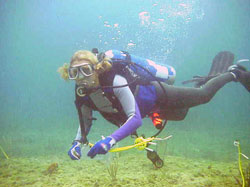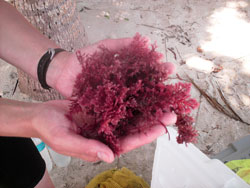Fogarty in Fiji: Searching for new drugs under the sea
May - June, 2009 | Volume 8, Issue 3
Cruising in the tropics surrounded by ocean, sunshine and mixed drinks is a daydream perhaps not out of the ordinary. What may be, however, is daydreaming about marine biology while tending bar on cruises to the Great Barrier Reef.
That's the unusual route Fogarty grantee Julia Kubanek took from her B.S. in chemistry from Queen's University at Kingston, Ontario, to academic stardom and recent publication in the prestigious Proceedings of the National Academy of Sciences.
She traces her current work as a Georgia Tech biologist and seeker of new life-saving drugs in the island nation of Fiji to family vacations at Cape Cod—taking whale-watching trips and "poking through the seaweed and looking at shells and crabs and stuff."

Photo by Joe Pawlik, UNC-Wilmington
Dr. Julia Kubanek dives in the Bahamas before her
current exploration of biodiversity in the Fiji Islands,
says support from Fogarty has brought together
social, political and natural scientists to help build
research infrastructure in developing nations.
Right now, Julia heads a lab that analyzes chemicals produced by seaweed, coral and sponges that defend the organisms from microbial attacks. Funded by the International Cooperative Biodiversity Groups program of Fogarty—in collaboration with eight other NIH components, the National Science Foundation and the U.S. Department of Agriculture—the project integrates research, training and economic development in countries with rich and relatively unspoiled ecosystems.
Nearly half of existing drugs originate from natural compounds, and the ones Julia's group is studying may hold the key to developing new drugs to fight diseases in the United States and abroad—from new antibiotics to attack newly resistant bacteria at home and anti-malaria therapies abroad. In addition, they have potential for use against cancer and HIV as well.
Scabs on seaweed
What made her latest research remarkable came about from a casual lunch with Georgia Tech colleague Dr. Facundo Fernandez, when it dawned on them that his work in mass spectrometry could have applications to her work on seaweed.
As a result, Julia recounts, "Dr. Fernandez's and my students were the first to locate the chemicals on the surface, and it was an unexpected patchy distribution of the antifungal defenses, and it had not been done before. To me it looked like there were scabs on the seaweed."
The implication, she says, is that an organism wounded by shallow-water agitation might send the army of chemical defenders right to the spot of the abrasion.

Photo by Julia Kubanek
A scientist holds a clump of the red seaweed
Callophycus serratus, whose disease-fighting
properties could one day help in the development
of new anti-malarials.
Corals, seaweed and sponges don't have a human-type of immunological response to attack. "The chemical defense they appear to have is a more ancestral form of defending oneself against a microorganism, and it seems to work pretty well," Julia explains.
Her team found the red clumpy seaweed while looking at other marine life on remote Yanuca Island and what turned out to be Callophycus serratus had never been chemically studied before.
The desorption electrospray ionization mass spectrometry (DESI-MS) technique Fernandez used is ideal for extracting molecules from a fragile organism at any temperature or pressure without having to prepare the sample.
"The tropical Pacific has probably the highest species diversity in coral reef systems in the world," Julia says. "It's accessible and there are a lot of different kinds of habitat for species to look at—shallow reefs, sloping reefs, walls and little atolls."
Just as important, she says, the political situation has stabilized, and local scientists are ready to start building research infrastructure than can lead to exchanges between the United States and Fiji.
An "ideal place"
"It's an ideal place," she says, noting, "To help countries like Fiji to have people who are trained to do their own research, who are investing in their own natural resources and therefore protecting them for the future because they know now the inherent value of those resources, that benefits the United States."
Besides the good will such programs engender, Julia says, "There is no longer the biodiversity in the United States that there was a couple of hundred years ago. But in developing countries, biodiversity still exists, and it serves the United States well to protect it and help the people who own that biodiversity build its value and capitalize on it."
The ICBG program "has been a great education for me—to be able to work with social scientists, political scientists and different kinds of natural scientists to study reef conservation, reef ecology and drug discovery. It's really a nice integrated program that helps each of those different activities add value to the others."
Daydream believer
Her father worked as a chemical engineer and her mother as a chemistry professor at a two-year college, so it was not surprising Julia majored in chemistry in Canada, where she was raised.
After college, "I spent two years out of school and I traveled to New Zealand and learned to scuba dive there. I had always been interested in the ocean as a kid, but as a young adult, I had not gravitated to that in school, and so I had sort of missed the boat, as it were."
She continues: "Then I was working basically as a bartender on these boats that went out to the Great Barrier Reef for diving. I started daydreaming about what I wanted to do. I did want to make a life out of science, but the general lab-based chemistry didn't really appeal to me. I wanted to do something connected to the environment."
Not wanting to start from the beginning with a degree in marine biology or oceanography, she found an adviser at the University of British Columbia who helped her apply her chemical background to biology.
Now, once a year, Julia's field trips—if scuba diving can be considered the "field"—take her to the islands of so many dreams.
Amy L. Lane, Leonard Nyadong, Asiri S. Galhena, Tonya L. Shearer, E. Paige Stout, R. Mitchell Parry, Mark Kwasnik, May D. Wang, Mark E. Hay, Facundo M. Fernandez and Julia Kubanek “Desorption electrospray ionization mass spectrometry reveals surface-mediated antifungal chemical defense of a tropical seaweed.” PNAS 2009 106:7314-7319.
To view Adobe PDF files,
download current, free accessible plug-ins from Adobe's website.